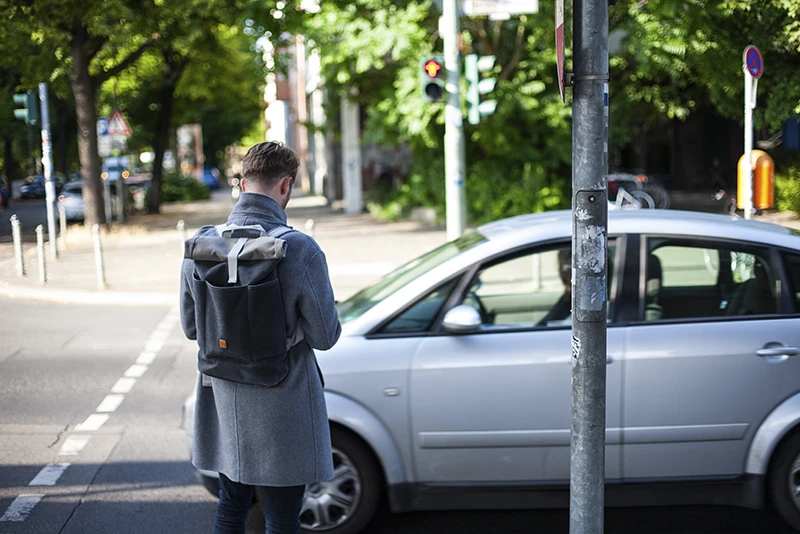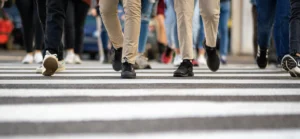If you or a loved one have been injured in a pedestrian accident in Birmingham, you’re not alone. The Alabama roads can be unforgiving, and the aftermath of an accident can leave you feeling overwhelmed and uncertain about the future.
At Nomberg Law Firm, we understand the physical, emotional and financial toll these accidents can take on you and your family. That’s why our experienced legal team has been dedicated to standing up for the rights of injured pedestrians in our community since 1967.
Our compassionate and skilled attorneys specialize in navigating the intricate laws of pedestrian accidents in Alabama and are committed to providing you with the personalized attention and aggressive representation you need to secure the justice and compensation you deserve.
Jump to section
Let us handle the legal burdens so you can focus on your recovery.
Contact us today for a free consultation, and take the first step toward reclaiming your life after a pedestrian accident.
How common are pedestrian accidents?
According to a report by the Governor’s Highway Safety Association (GHSA), in 2022 alone, drivers hit and killed at least 7,508 pedestrians, marking the highest yearly toll since 1981. This grim statistic averages to around 20 pedestrian deaths daily.
The report also found that pedestrian fatalities increased a whopping 77% from 2010-2021, a startling rate, especially compared to the rise in all other traffic deaths, which was only 25% during that same period. Sadly, this trend doesn’t seem to be showing any signs of slowing. In fact, since just 2019, pedestrian fatalities have risen almost 20%.
In Alabama, the pedestrian fatality rate in 2022 was 1.02 per 100,000 residents, with other U.S. states falling somewhere between 0.27 and 1.99 per 100,000 residents.
Common characteristics of pedestrian accidents
The National Highway Traffic Safety Administration (NHTSA) publishes an annual report with pedestrian accident statistics and characteristics. Below are some of its key findings in 2021 traffic crashes involving pedestrian fatalities:
- A significant majority (84%) of pedestrian fatalities occurred in urban areas, compared to 16% in rural areas.
- Pedestrian fatalities occurred predominantly outside of intersections (75%), with 16% at intersections and 9% at other locations like roadsides, parking zones, bicycle lanes, sidewalks, and various other sites.
- The majority of pedestrian fatalities happened in the dark (77%), compared to daylight (20%), dusk (2%), and dawn (2%).
- Nearly half (49%) of all fatal pedestrian crashes involved alcohol, with either the driver or pedestrian having a blood alcohol concentration (BAC) of 0.01 grams per deciliter (g/dL) or higher.
What is the most frequent cause of pedestrian accidents?
Pedestrian accidents are often the result of a combination of factors, with the following being some of the most frequent causes:
- Alcohol and drug use. Accidents often occur when either the driver or pedestrian is impaired by alcohol or drugs, affecting their judgment and reaction times.
- Speeding. Speeding reduces a driver’s and pedestrian’s reaction time and increases the severity of impacts in accidents.
- Failure to yield the right of way. Many accidents happen when drivers do not yield to pedestrians at crosswalks and intersections.
- Poor visibility. Conditions like nighttime, bad weather, or poorly lit areas contribute to a higher rate of pedestrian accidents.
- Ignoring traffic signals. Accidents often result from both drivers and pedestrians disregarding traffic lights and signs.
- Distraction. Using cell phones or other distractions while driving increases the risk of failing to notice pedestrians, while pedestrians distracted by smartphones or headphones may unintentionally walk into dangerous situations.
- Left-hand turns. Drivers focused on navigating intersections during left-hand turns may overlook pedestrians.
- Unmarked crosswalks. Higher frequency of accidents occurs in areas where pedestrian paths are not clearly marked.
- Road design. Roads lacking pedestrian safety features, such as sidewalks and crosswalks, are more prone to pedestrian accidents.
What are the most common pedestrian injuries?
Pedestrian accidents often result in severe injuries due to the vulnerability of pedestrians when colliding with vehicles. Common injuries include:
- Head injuries, such as concussions, brain bleeds and other traumatic brain injuries, resulting from impacts with the vehicle or ground
- Broken bones, particularly in the legs, arms, hips and pelvis, due to the collision’s force
- Soft tissue injuries, including bruises, lacerations and sprains, often occurring from the initial impact or the pedestrian falling to the ground
- Spinal cord injuries, ranging from minor to severe, potentially leading to paralysis
- Internal injuries, like internal bleeding and organ damage, which can be life-threatening
- Neck injuries, such as whiplash, from the sudden, forceful movement during the collision
Additionally, pedestrian accidents often lead to significant psychological trauma, including post-traumatic stress disorder (PTSD), anxiety and depression, which can take years to fully recover from.
What is the pedestrian law in Alabama?
In Alabama, pedestrian laws, primarily found in Alabama Code Section 32-5A, outline the rules that both pedestrians and drivers must follow while traversing the roads. Key points in the law include the following:
- Pedestrians must obey all traffic control devices.
- Drivers are required to yield to pedestrians in crosswalks.
- Pedestrians crossing roads outside of crosswalks must yield to vehicles.
- Pedestrians should not abruptly enter traffic from a curb.
- Pedestrians on sidewalks have the right-of-way over vehicles.
- Pedestrians are required to use sidewalks when available, instead of walking on the road.
- Pedestrians are prohibited from hitchhiking.
- Pedestrians significantly impaired by alcohol or drugs cannot be on highways.
Regardless of whether you’re a driver or a pedestrian, it’s crucial to be familiar with these laws to prevent a tragic accident and protect your rights in the event that an accident does occur.
Do pedestrians have the right of way in Alabama?
In Alabama, pedestrians do have the right of way under certain circumstances, but this right is not absolute. According to Alabama state law, pedestrians have the right of way in all marked crosswalks and intersections, where drivers are expected to yield to them.
However, pedestrians must also adhere to traffic signals and use crosswalks where available. Outside of these marked areas, pedestrians are required to yield the right of way to vehicles on the road.

Is jaywalking illegal in Alabama?
Jaywalking, or the act of crossing the street outside of a designated crosswalk or intersection, is considered illegal in Alabama. State law mandates that pedestrians must use crosswalks when they’re available and obey all traffic signals.
When crossing a road at any point other than a marked crosswalk or an intersection, pedestrians must yield the right-of-way to all vehicles. This law is designed to prevent accidents and ensure the safety of both pedestrians and motorists by discouraging crossing roads in an unpredictable or unsafe manner.
How is fault determined in a pedestrian accident?
Proving fault or negligence in a pedestrian accident involves assessing the actions of both the pedestrian and the driver in relation to the laws and road safety norms. The process typically depends on the following types of evidence:
- Examination of traffic laws. The primary reference point is the local traffic laws, which dictate right-of-way, pedestrian crossings, traffic signals and jaywalking regulations. Both parties’ adherence to these laws is crucial in fault determination.
- Investigation of the accident scene. Investigators look at the accident scene for evidence like skid marks, traffic signs, pedestrian signals and road conditions. This helps in reconstructing the accident and understanding the context.
- Witness statements. Testimonies from people who saw the accident can provide crucial information about the actions of both the driver and the pedestrian.
- Surveillance footage. If available, traffic or security camera footage can give an unbiased view of the accident.
- Driver and pedestrian behavior. Factors like speeding, distracted driving, alcohol impairment, ignoring traffic signals or crossing outside of a crosswalk are considered. The degree to which each party’s behavior contributed to the accident is assessed.
- Police reports. Police officers responding to the scene will usually write a report that includes their observations and sometimes an initial assessment of fault.
- Involvement of accident reconstruction experts. In some cases, specialists are called in to reconstruct the accident and provide a professional opinion on the dynamics of the collision.
- Insurance company evaluation. Insurance adjusters will conduct their own investigation to determine fault, especially when it comes to settling claims.
If it’s determined that the other party was at fault for the accident, the injured party may be able to recover compensation for damages like past and future medical expenses and lost wages, pain and suffering, emotional distress and more.
Is Alabama a no-fault state?
No, Alabama is not a no-fault state. Instead, it follows a “pure contributory negligence” rule for determining fault in accidents, including vehicle and pedestrian accidents. The pure contributory negligence rule is one of the strictest forms of negligence law in the U.S.
Under this rule, if an injured party is found to be even slightly at fault for the accident (as little as 1%), they cannot recover any damages from the other party. This means that if a pedestrian or driver is deemed to have contributed in any way to the accident, they are barred from receiving compensation from the other party involved.
Here’s an example:
Let’s say a pedestrian was hit by a drunk driver, but they were looking down at their phone at the time of the accident while legally crossing at a crosswalk. In such a case, the pedestrian would likely be found partially at fault for being distracted by their phone. In Alabama, because of the pure contributory negligence rule, that pedestrian would not be able to recover any damages from the driver, even if the driver was at fault to a much greater degree.
The pure contributory negligence rule places a high premium on establishing clear fault in legal disputes following an accident, making it crucial to seek the assistance of an experienced accident attorney as early on in the process as possible to protect your rights.
When you choose Nomberg Law Firm for your pedestrian accident case, you gain a powerful ally with no financial risk upfront
Free expert advice, no initial investment.
Our initial consultation is completely free. We offer valuable legal advice and insights into your case without any initial cost to you.
No win, no fee assurance.
We work on a contingency fee basis. This means if we don’t win your case, you don’t pay any attorney fees. Your success is our success.
Collaboration with industry experts.
We collaborate with industry experts, including medical professionals and accident reconstruction specialists, to build a robust case and provide a comprehensive understanding of your claim.
Maximizing your compensation.
As seasoned pedestrian accident attorneys, we understand the true value of your claim. We are dedicated to ensuring you receive the full compensation you deserve, not just what the insurance company offers. Statistically, injury victims represented by attorneys secure significantly higher financial settlements.
Contact the Nomberg Law Firm for help with your pedestrian accident claim in Alabama
If you’ve been involved in a pedestrian accident in Alabama and are seeking just compensation for your injuries, Nomberg Law Firm is here to help. With a longstanding presence in Birmingham, our experienced team is dedicated to helping accident victims recover fair compensation for their injuries.
We understand the complexities of Alabama’s pedestrian accident laws and are committed to providing you with the skilled legal representation you need to navigate your claim successfully.
Contact our office today for a free consultation so we can help protect your rights and get you the compensation you deserve.
